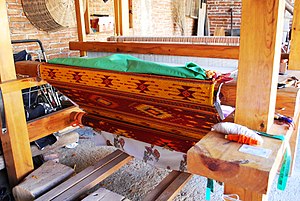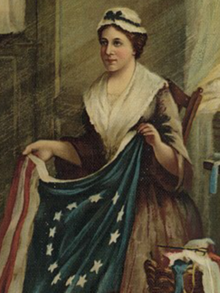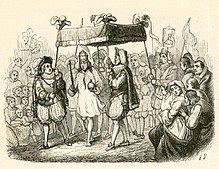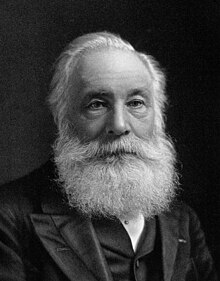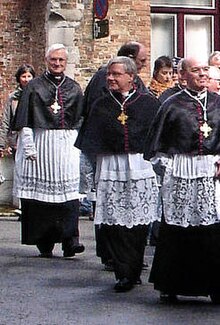Portal:Clothing
The Clothing Portal

Clothing (also known as clothes, garments, dress, apparel, or attire) is any item worn on the body. Typically, clothing is made of fabrics or textiles, but over time it has included garments made from animal skin and other thin sheets of materials and natural products found in the environment, put together. The wearing of clothing is mostly restricted to human beings and is a feature of all human societies. The amount and type of clothing worn depends on gender, body type, social factors, and geographic considerations. Garments cover the body, footwear covers the feet, gloves cover the hands, while hats and headgear cover the head, and underwear covers the private parts.
Clothing has significant social factors as well. Wearing clothes is a variable social norm. It may connote modesty. Being deprived of clothing in front of others may be embarrassing. In many parts of the world, not wearing clothes in public so that genitals, breast, or buttocks are visible could be considered indecent exposure. Pubic area or genital coverage is the most frequently encountered minimum found cross-culturally and regardless of climate, implying social convention as the basis of customs. Clothing also may be used to communicate social status, wealth, group identity, and individualism. (Full article...)
Textile is an umbrella term that includes various fiber-based materials, including fibers, yarns, filaments, threads, different fabric types, etc. At first, the word "textiles" only referred to woven fabrics. However, weaving is not the only manufacturing method, and many other methods were later developed to form textile structures based on their intended use. Knitting and non-woven are other popular types of fabric manufacturing. In the contemporary world, textiles satisfy the material needs for versatile applications, from simple daily clothing to bulletproof jackets, spacesuits, and doctor's gowns. (Full article...)
Textile arts are arts and crafts that use plant, animal, or synthetic fibers to construct practical or decorative objects. (Full article...)
Selected articles -
-

A woman from Ramallah, c. 1929–1946
Palestinian traditional clothing are the types of clothing historically and sometimes still presently worn by Palestinians. Foreign travelers to Palestine in the 19th and early 20th centuries often commented on the rich variety of the costumes worn, particularly by the fellaheen or village women. Many of the handcrafted garments were richly embroidered and the creation and maintenance of these items played a significant role in the lives of the region's women.
Though experts in the field trace the origins of Palestinian costumes to ancient times, there are no surviving clothing artifacts from this early period against which the modern items might be definitively compared. Influences from the various empires to have ruled Palestine, such as Ancient Egypt, Ancient Rome and the Byzantine empire, among others, have been documented by scholars largely based on the depictions in art and descriptions in literature of costumes produced during these times. (Full article...) -

Indigo dye is an organic compound with a distinctive blue color. Indigo is a natural dye extracted from the leaves of some plants of the Indigofera genus, in particular Indigofera tinctoria. Dye-bearing Indigofera plants were commonly grown and used throughout the world, particularly in Asia, with the production of indigo dyestuff economically important due to the historical rarity of other blue dyestuffs.
Most indigo dye produced today is synthetic, constituting around 80,000 tonnes each year, as of 2023. It is most commonly associated with the production of denim cloth and blue jeans, where its properties allow for effects such as stone washing and acid washing to be applied quickly. (Full article...) -

Cotton corduroy
Corduroy is a textile with a distinctively raised "cord" or wale texture. Modern corduroy is most commonly composed of tufted cords, sometimes exhibiting a channel (bare to the base fabric) between them. Both velvet and corduroy derive from fustian fabric. Corduroy looks as if it is made from multiple cords laid parallel to each other. (Full article...) -
Rug in progress in Teotitlan del Valle, Oaxaca
The textiles of Mexico have a long history. The making of fibers, cloth and other textile goods has existed in the country since at least 1400 BCE. Fibers used during the pre-Hispanic period included those from the yucca, palm and maguey plants as well as the use of cotton in the hot lowlands of the south. After the Spanish conquest of the Aztec Empire, the Spanish introduced new fibers such as silk and wool as well as the European foot treadle loom. Clothing styles also changed radically. Fabric was produced exclusively in workshops or in the home until the era of Porfirio Díaz (1880s to 1910), when the mechanization of weaving was introduced, mostly by the French.
Today, fabric, clothes and other textiles are both made by craftsmen and in factories. Handcrafted goods include pre-Hispanic clothing such as huipils and sarapes, which are often embroidered. Clothing, rugs and more are made with natural and naturally dyed fibers. Most handcrafts are produced by indigenous people, whose communities are concentrated in the center and south of the country in states such as Mexico State, Oaxaca and Chiapas. The textile industry remains important to the economy of Mexico although it has suffered a setback due to competition by cheaper goods produced in countries such as China, India and Vietnam. (Full article...) -

Drawing of a baldachin over a throne, placed on a dais
A baldachin, or baldaquin (from Italian: baldacchino), is a canopy of state typically placed over an altar or throne. It had its beginnings as a cloth canopy, but in other cases it is a sturdy, permanent architectural feature, particularly over high altars in cathedrals, where such a structure is more correctly called a ciborium when it is sufficiently architectural in form. Baldachins are often supported on columns, especially when they are disconnected from an enclosing wall. A cloth of honour is a simpler cloth hanging vertically behind the throne, usually continuing to form a canopy. It can also be used for similar canopies in interior design, for example above beds, and for processional canopies used in formal state ceremonies such as coronations, held up by four or more men with poles attached to the corners of the cloth.
"Baldachin" was originally a luxurious type of cloth from Baghdad, from which name the word is ultimately derived, appearing in English as "baudekin" and other spellings. Matthew Paris records that Henry III of England wore a robe "de preciosissimo baldekino" at a ceremony at Westminster Abbey in 1247. The word for the cloth became the word for the ceremonial canopies made from the cloth. (Full article...) -
Elizabeth Griscom Ross (née Griscom; January 1, 1752 – January 30, 1836), also known by her second and third married names, Ashburn and Claypoole, was an American upholsterer who was credited by her relatives in 1870 with making the second official U.S. flag, accordingly known as the Betsy Ross flag. Though most historians dismiss the story, Ross family tradition holds that General George Washington, commander-in-chief of the Continental Army and two members of a congressional committee—Robert Morris and George Ross—visited Mrs. Ross in 1776. Mrs. Ross convinced George Washington to change the shape of the stars in a sketch of a flag he showed her from six-pointed to five-pointed by demonstrating that it was easier and speedier to cut the latter. However, there is no archival evidence or other recorded verbal tradition to substantiate this story of the first U.S. flag. It appears that the story first surfaced in the writings of her grandson in the 1870s (a century after the fact), with no mention or documentation in earlier decades.
Ross made flags for the Pennsylvanian navy during the American Revolution. After the Revolution, she made U.S. flags for over 50 years, including 50 garrison flags for the U.S. Arsenal on the Schuylkill River during 1811. The flags of the Pennsylvania navy were overseen by the Pennsylvania Navy Board. The board reported to the Pennsylvania Provincial Assembly's Committee of Safety. In July 1775, the President of the Committee of Safety was Benjamin Franklin. Its members included Robert Morris and George Ross. At that time, the committee ordered the construction of gunboats that would eventually need flags as part of their equipment. As late as October 1776, Captain William Richards was still writing to the committee or Council of Safety to request the design that he could use to order flags for their fleet. (Full article...) -
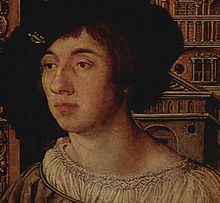
Smocking on the collar of a sixteenth-century garment
Smocking is an embroidery technique used to gather fabric so that it can stretch. Before elastic, smocking was commonly used in cuffs, bodices, and necklines in garments where buttons were undesirable. Smocking developed in England and has been practised since the Middle Ages and is unusual among embroidery methods in that it was often worn by labourers. Other major embroidery styles are purely decorative and represented status symbols. Smocking was practical for garments to be both form fitting and flexible, hence its name derives from smock — an agricultural labourer's work shirt. Smocking was used most extensively in the eighteenth and nineteenth centuries. (Full article...) -
Courtaulds was a United Kingdom-based manufacturer of fabric, clothing, artificial fibres, and chemicals. It was established in 1794 and became the world's leading man-made fibre production company before being broken up in 1990 into Courtaulds plc and Courtaulds Textiles Ltd. (Full article...)
-
"The Emperor's New Clothes" (Danish: Kejserens nye klæder [ˈkʰɑjsɐns ˈnyˀə ˈkʰlɛːðə]) is a literary folktale written by Danish author Hans Christian Andersen, about a vain emperor who gets exposed before his subjects. The tale has been translated into over 100 languages.
"The Emperor's New Clothes" was first published with "The Little Mermaid" in Copenhagen, Denmark, by C. A. Reitzel, on 7 April 1837, as the third and final installment of Andersen's Fairy Tales Told for Children. The tale has been adapted to various media, and the story's title, the phrase "the Emperor has no clothes", and variations thereof have been adopted for use in numerous other works and as idioms. (Full article...) -
Goldwork is the art of embroidery using metal threads. It is particularly prized for the way light plays on it. The term "goldwork" is used even when the threads are imitation gold, silver, or copper. The metal wires used to make the threads have never been entirely gold; they have always been gold-coated silver or cheaper metals, and even then the "gold" often contains a very low percent of real gold. Most metal threads are available in silver and sometimes copper as well as gold; some are available in colors as well.
Goldwork is always surface embroidery and free embroidery; the vast majority is a form of laid work or couching; that is, the gold threads are held onto the surface of the fabric by a second thread, usually of fine silk. The ends of the thread, depending on type, are simply cut off, or are pulled through to the back of the embroidery and carefully secured with the couching thread. A tool called a mellore or a stilleto is used to help position the threads and create the holes needed to pull them through. The threads most often have metal or gold leaf wound around a textile thread, or threads treated with an adhesive and rolled in powdered gold or other metal. (Full article...) -

Mascarade à l'éléphant, also known as Elephant (387 x 640 cm. ; 152 x 252 in.)
The Valois Tapestries are a series of eight large tapestries depicting festivities or "magnificences" held by Catherine de' Medici's Royal Courts in the second half of the 16th century. The tapestries were primarily modeled on drawings by Antoine Caron, but to Caron's distant views of large panoramas crowded with figures much larger portraits of leading persons at the French court have been added in the foreground, usually to the side, as well as elaborate borders.
They were produced by teams of weavers in the Spanish Netherlands, probably in Brussels or Antwerp, shortly after 1580. A number of great artists and artisans worked on the creation of these tapestries but today we are left with nothing but theories and speculation to their identities. Scholars such as Frances Yates and Jean Coural have developed nuanced theories backed by solid evidence to identify these unknown contributors, and also the political meaning of the tapestries, but research has yet to confirm many of these findings. These works display surprisingly intimate and personal moments within the royal inner circle clashing against the busy backdrops of these lavish festivals. (Full article...) -
Sir William Henry Perkin FRS (12 March 1838 – 14 July 1907) was a British chemist and entrepreneur best known for his serendipitous discovery of the first commercial synthetic organic dye, mauveine, made from aniline. Though he failed in trying to synthesise quinine for the treatment of malaria, he became successful in the field of dyes after his first discovery at the age of 18.
Perkin set up a factory to produce the dye industrially. Lee Blaszczyk, professor of business history at the University of Leeds, states, "By laying the foundation for the synthetic organic chemicals industry, Perkin helped to revolutionize the world of fashion." (Full article...) -
The "sweater curse" or "curse of the love sweater" is a term used by knitters and crocheters to describe the belief that if a knitter or crocheter gives a hand-knit sweater to a significant other, it will lead to the recipient breaking up with the knitter. In an alternative formulation, the relationship will end before the sweater is even completed. The belief is widely discussed in knitting publications, and some knitters claim to have experienced it. In a 2005 poll, 15% of active knitters said that they had experienced the sweater curse firsthand, and 41% considered it a possibility that should be taken seriously.
Despite its name, the "sweater curse" is treated in knitting literature not as a superstition governed by paranormal forces, but rather as a real-world pitfall of knitting that has rational explanations. Several plausible mechanisms for the sweater curse have been proposed, but it has not been studied systematically. (Full article...) -

Striking CIO mill workers in Georgia, May 1941.
Emil Rieve (June 8, 1892 – January 24, 1975) was an American labor leader. He was president of the Textile Workers Union of America (TWUA) from 1939 to 1956, a vice president of the Congress of Industrial Organizations (CIO) from 1939 to 1955, and a vice president of the AFL-CIO from 1955 to 1960.
Emil Rieve was born in Poland and moved to Pennsylvania as a child. He left school early and first became a union member at age fifteen, quickly rising within the union hierarchy. He organized his first strike in 1930 in Reading, Pennsylvania. His aggressive drives to unionize the region's textile workers and achieve union recognition led to the Reading Formula of 1933 in negotiating with the National Labor Board, a precedent which resolved large numbers of other labor disputes. Rieve was a major figure in the unsuccessful textile workers strike of 1934. When the Congress of Industrial Organizations formed the following year, Rieve received international recognition for his efforts to avoid a rift with the American Federation of Labor. (Full article...) -
Catholic clergymen wearing pleated rochets
A pleat (plait in older English) is a type of fold formed by doubling fabric back upon itself and securing it in place. It is commonly used in clothing and upholstery to gather a wide piece of fabric to a narrower circumference.
Pleats are categorized as pressed, that is, ironed or otherwise heat-set into a sharp crease, or unpressed, falling in soft rounded folds. Pleats sewn into place are called tucks. (Full article...)
Did you know (auto generated)

- ... that during a renovation of 4 Park Avenue, workers found a sealed room with women's clothes and shoes that was not in the building's blueprints?
- ... that pioneering Daily News camerawoman Evelyn Straus had her clothes custom-made to carry her film and flashbulbs?
- ... that after being criticized for dressing "like a doll" at an important meeting, pioneering Russian feminist Anna Filosofova replied that "clothes do not make the woman"?
- ... that according to Brandy Hellville, executives at Brandy Melville have bought the clothes off of employees' backs?
- ... that Liberian paramount chief Tamba Taylor worked as a tailor and claimed to have sewn clothes for Ethiopian emperor Haile Selassie and Ghanaian president Kwame Nkrumah?
- ... that Church Clothes 4 deals with Christian hip hop artist Lecrae's faith deconstruction and reconstruction?
More Did you know
- ...that besides utility poles (example pictured), anonymous knitters from Knitta have also left their tags on the Great Wall of China and the Notre-Dame de Paris?
- ...that textile arts are those arts and crafts that use plant, animal, or synthetic fibers to construct and decorate objects such as clothing, carpets, and curtains?
- ...that factors affecting the preservation of textiles include ambient heat, light, and humidity, and the presence of pests, airborne chemicals and pollutants?
Related portals
Selected image
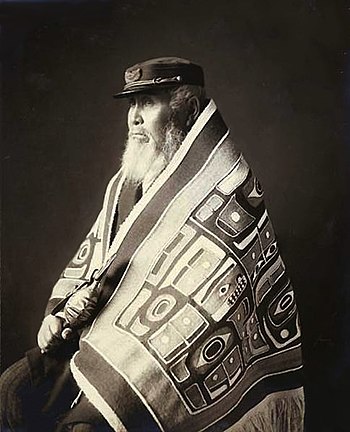
Chilkat weaving is a traditional form of weaving practiced by Tlingit, Haida, Tsimshian, and other Northwest coastal tribes of Alaska and British Columbia. Chilkat blankets are worn by high-ranking tribal members on civic or ceremonial occasions, including dances.
General images -
-
Indigenous Americas Map Tunic designed in 2018 by Carla Fernández and Pedro Reyes for Taller Flora. (from Fashion)
-
A see-through top worn along with pasties by a model at a fashion show in US, 2017. Such fashion trends get popularised through media. (from Fashion)
-
A woman in Bengal region in the eastern part of the Indian subcontinent, clad in fine Bengali muslin, 18th century. (from History of clothing and textiles)
-
Bella Hadid at the Cannes Film Festival (from Fashion)
-
Gensei Kajin Shu by Yoshu Chikanobu, 1890. Various styles of traditional Japanese clothing and Western styles. (from Fashion)
-
A Mexican sports reporter Inés Sainz wearing a little black dress and knee-high boots (from Fashion)
-
Cover of Marcus Clarks' spring and summer catalogue 1926–27 (from Fashion)
-
Liu Wen, supermodel, walks the runway modeling fashions by designer Diane von Fürstenberg at New York Fashion Week 2013. (from Fashion)
-
Edgar I of England in short tunic, hose, and cloak, 966 (from History of clothing and textiles)
-
Latin dancers in their costumes. The woman is wearing backless dress with deep slits on its lower portion, while the man is wearing a shirt with top buttons open. (from Fashion)
-
Estonian national clothes are a fine example of change in clothing after the industrial revolution. They changed a lot during 18th and 19th of century with the addition of new types of colors (like aniline dyes), placement of colors (like lengthwise stripes) and with the addition of new elements (like waistcoats). By the end of the 19th century they went out of use in most of the country (except more remote places as in Kihnu island) and it was only in mid 20th century when they once again gained popularity and now as a formal clothing. Members of University of Tartu Folk Art Ensemble wearing clothes specific to Kihnu island, Tori Parish (women in red skirts) and Tõstamaa area (men in brown clothing). (from History of clothing and textiles)
-
14th-century Italian silk damasks (from History of clothing and textiles)
-
Celebrities such as Britney Spears have popularized the concept of wearing underwear as outerwear. (from Fashion)
-
The Boxer Codex, showing the attire of a Classical period Filipino, made of silk and cotton (from History of clothing and textiles)
-
This 1921 clipping from the St. Louis Post-Dispatch, with story and drawings by Marguerite Martyn, represents the saturation newspaper coverage given to society women at a fashionable dance. (from Fashion)
-
Model with a modern dress reflecting the current fashion trend at a fashion show, Paris, 2011 (from Fashion)
-
Tie dye vendor, July 2013 (from Fashion)
-
Marie Antoinette, wife of Louis XVI, was a leader of fashion. Her choices, such as this 1783 white muslin dress called a chemise a la Reine, were highly influential and widely worn. (from Fashion)
-
Textile machinery at the Cambrian Factory, Llanwrtyd, Wales in the 1940s (from History of clothing and textiles)
-
Jacqueline Kennedy, the wife of President John F. Kennedy, made pink a popular high-fashion color. (from Fashion)
-
Kaia Gerber at the 2019 Max Mara Fashion Week in Milan (from Fashion)
-
Albrecht Dürer's drawing contrasts a well-turned out bourgeoise from Nuremberg (left) with her counterpart from Venice. The Venetian lady's high chopines make her look taller. (from Fashion)
-
Bold floral patterned silks, 15th century (from History of clothing and textiles)
-
A French reinterpretation of Spanish fashion, with elaborate reticella ruff, 1609 (from History of clothing and textiles)
-
Timberland boots are an everyday shoe in streetwear. (from Fashion)
-
Gross sales of goods vs IP laws (US 2007) (from Fashion)
-
"Swinging London": Young adults in London's Carnaby Street. (from Fashion)
Selected quote
Main topics
Recognized content
Extended content
| ||
|---|---|---|
Featured articlesGood articlesFeatured pictures
Featured portals
|
Subcategories
WikiProjects
- Parent project
- Main project
- Participants
- Related projects
WikiProject Fashion • WikiProject Knots • WikiProject Sculpture • WikiProject Visual arts
What are WikiProjects?
Things you can do
Associated Wikimedia
The following Wikimedia Foundation sister projects provide more on this subject:
-
Commons
Free media repository -
Wikibooks
Free textbooks and manuals -
Wikidata
Free knowledge base -
Wikinews
Free-content news -
Wikiquote
Collection of quotations -
Wikisource
Free-content library -
Wikiversity
Free learning tools -
Wiktionary
Dictionary and thesaurus





